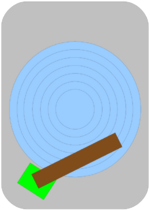Hard disk: Difference between revisions
imported>Eric M Gearhart (Added drawing and section describing the inner workings) |
imported>Stephen Ewen m (image) |
||
| Line 6: | Line 6: | ||
==Description of the inner workings== | ==Description of the inner workings== | ||
[[Image:Hard disk.png|right|thumb| | [[Image:Hard disk.png|right|thumb|150px|{{Hard disk.png/credit}}]] | ||
Data is written onto metal platters via an arm with a read/write head on the end of it. This arm is depicted in the image shown in this section as the brown line that is attached to the green box. | Data is written onto metal platters via an arm with a read/write head on the end of it. This arm is depicted in the image shown in this section as the brown line that is attached to the green box. | ||
Revision as of 13:12, 21 October 2007
A hard disk or hard drive is one component of a modern computer. It is the physical device that holds data on a permanent basis, also known as "secondary storage."
A hard disk should not be confused with a 3.5" floppy disk - although "hard disk" sounds like a description of the plastic-covered disk, "floppy disk" is a more accurate description.
Description of the inner workings
Data is written onto metal platters via an arm with a read/write head on the end of it. This arm is depicted in the image shown in this section as the brown line that is attached to the green box.
The magnetic field of the area where the read/write head happens to be determines whether the data that gets recorded is a 1 or a 0.
The platter the arm writes to is depicted as the blue circles. Tracks on the platter are shown as concentric circles.
Examples in conversation
- When a user "saves a document to the desktop" they have open, typically they are saving their work to a hard disk.
- When you first start your computer, the operating system that starts after a few seconds boots from the hard drive.
